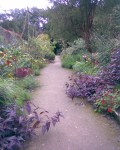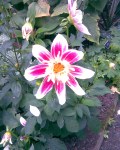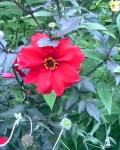Altough not coastal, Kilmacurragh House and Arboretum is not far from Brittas contains a 17th century manor and Victorian garden which was established by the Acton family. The house is preserved as a ruin and the world famous arboretum have rare and exotic plants established by a seafaring member of the Acton family, Here are a few of the many plants and trees. Well worth a visit with the family and friends. Toilet facilities. The property is maintained by the state.







Archive for September, 2009
A Visit to Kilmacurragh
Posted in Uncategorized on September 28, 2009| Leave a Comment »
Many thanks!
Posted in Uncategorized on September 26, 2009| Leave a Comment »
Many thanks to all who took part in the September beach clean. The weather was absolutely gorgeous. Hopefully all who stayed on for a swim got back to shore ok. While walking the dogs on the beach the other night my torch picked out a strange shape on the sand. I photgraphed the obect with my phone which I would like to share with you.
I have been a compulsive beachwalker for over 50 years and have seen many strange sites. Never have I been so stunned by a work of such intricacy and beauty as this. I would like to thank whoever went to the trouble of putting it together. Almost a week later and it is still there.
Like the beach itself, it symbolises a fleeting moment in the seemingly eternal life of a seashore.

SEPTEMBER BEACHCLEAN
Posted in Uncategorized on September 18, 2009| Leave a Comment »
ON SATURDAY 26TH SEPTEMBER, THE MONTHLY BEACHCLEAN WILL TAKE PLACE. STARTING AT THE SOUTH BEACH CAR PARK IN BRITTAS BAY AT NOON, THE EVENT WILL LAST FOR 1 HOUR. ALL ARE WELCOME TO TAKE PART IN THIS FUN ACTIVITY WHICH LENDS ITSELF TO FAMILY PARTICIPATION OFTEN INVOLVING THREE GENERATIONS INTERACTING IN TACKLING THE USUAL BEACH DEBRIS IN THE DUNES AND FORESHORE. BAGS, GLOVES AND LITTERPICKERS PROVIDED
Green Communities
Posted in Uncategorized on September 10, 2009| Leave a Comment »
The Brittas Bay Coastcare Group have joined the Green Communities initiative and will shortly be conducting a habitat survey. 
Captain Jack White, Smuggler
Posted in Uncategorized on September 8, 2009| Leave a Comment »
JACK WHITE THE SMUGGLER
Because of England’s restrictive trade laws against Ireland during the 17th and 18th centuries smuggling was rampant through all levels of society. Nearly everyone benefited from clandestine trade, from magistrates, clergymen, Justices of the Peace, down to the tenant farmer, boat owner and peasant.
All groups contrived in some way or another to keep smuggling going In most of the county’s anti-commerce laws concerned the shipping of goods out of Ireland to foreign destinations and the importation of merchandise from abroad.
One of the most flouted taws was one by which England insisted that all foreign trade in and out of this country had to be conducted in English ships. This was all very fine when Europe was at peace but if England was at war with any neighboring country it meant that no Irish goods
could be sent to that country.
Outside of the United Kingdom lreland’s principal business market was France. Unfortunately, for much of the 17th and 18th centuries England and France were enmeshed in war and Ireland’s trade consequently suffered
As often as not during these times smuggling on a grand scale between Ireland and France was the only, way in which their trade could be conducted. So widespread was smuggling along the coast by all and sundry that it was hardly regarded as a crime at all.
Except in tintes of invasion scares, or when the government coffers ran so low they faced bankruptcy, did the ineffectual revenue men try to crack down Such action was rarely successful, however, because there were so many vested interests lined up against enforcement.
Jack Whyte or White which tradition states lived at the turn of the 17th century, was reputed to be a first class smuggler. He regularly arranged for shipments of Wicklow wool to be sent abroad to France in exchange for wine, brandy and French luxury goods Operating out of Ardinary and “Jack’s Hole”, the French ships would anchor long enough there to load up bales of wool and hides and off-load the spirits.
Other than the odd English naval ship patrolling in the Irish Sea, or an over-zealous revenue officer in the district (which was not very often), the risk of being caught smuggling was slight It was the gentry who were the main customers for luxury goods and spirits and it was these same people who were supposed to enforce the law
White had a close `business arrangement’ with Thomas Acton of Kilmacurragh in the sale and distribution of smuggled goods. Acton was a powerful and important patron in the area. He was a Justice of the Peace and part-time magistrate. On the old coach-road from the sea coast to the interior of the county’ in the townland of Ballinpark, Jack White kept a sheebeen or whiskey house. It was here the recipients came to receive their `cut’ of the spoils, each getting a portion of the smuggled materials in keeping with outlay In either 1700 or 1731, tradition is not clear which year, a particularly rich cargo of goods were landed at ‘Jack’s Hole’ and conveyed to White’s Here a falling out occurred between Acton and the smuggler over the contraband. In the ensuing quarrel Acton, who shared many an illegal
cargo organized by lack White, had him arrested.
White was tried by Acton and another Wicklow gentleman magistrate William Hoey of Dunganstown, who was also a regular user
of his services
They sentenced him to death. Jack White was believed to have been hanged by the sea on a cliff overlooking `Jack’s Hole’, (now the site Of the old Coastguard buildings). “Jack White’s of the Cross” was named because it was very near the smuggler’s original premises, or because it may occupy the actual ground. No burial place for him is known, nor is there likely to be one, as the bodies of almost all felons executed at that time were usually simply thrown into the sea.
(Taken from Jack Whites Inn website. see link)
Coastal vegetation in Brittas
Posted in Ecology, Uncategorized on September 2, 2009| Leave a Comment »
On higher parts of the beach; the following typical annual strandline vegetation can be found such as:
- Sea Rocket
- Spear leaved Orache
- Prickly Saltwort
- Yellow-honed poppy.
Embryonic dune development occurs at the southern end of Brittas and more widely at Buckroney and Pennycomequick, where the following species can be found;
- Couch-grass
- Sand Sedge
- Sea Sandwort.
The main dune ridges are dominated by Marram with herbaceous secies such as;
- Sea Splurge
- Sea Holly
- Rest Harrow
For further information on the sand dune system in Brittas see the Brittas Bay and Buckroney sand dune and fen system link from which the above information has been taken
Photo Contest
Posted in beach events, Uncategorized on September 2, 2009| Leave a Comment »
Below are a list of the sucessful entrants in the Photo contest run by the Arklow and Brittas Bay Coastcare Groups.
Congratulations to the winners and thanks to all who entered